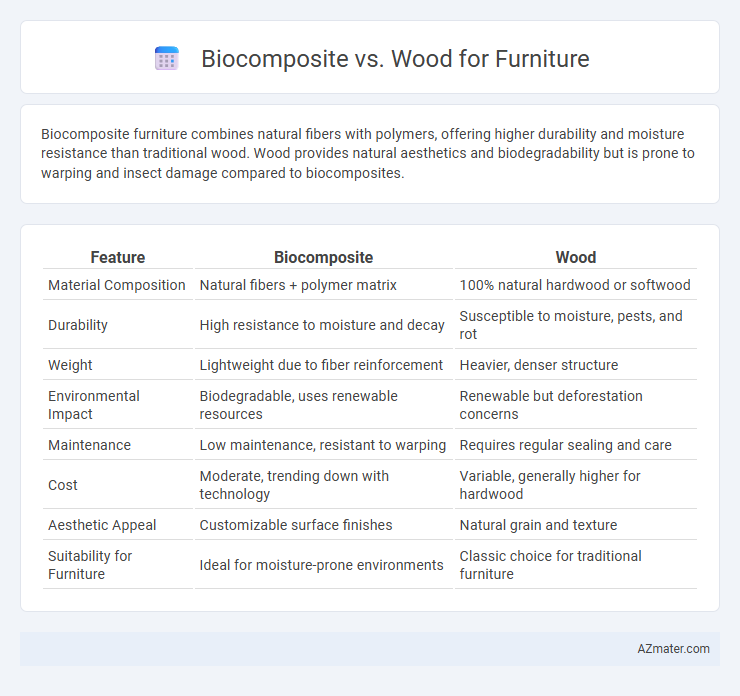Biocomposite furniture combines natural fibers with polymers, offering higher durability and moisture resistance than traditional wood. Wood provides natural aesthetics and biodegradability but is prone to warping and insect damage compared to biocomposites.
Table of Comparison
| Feature | Biocomposite | Wood |
|---|---|---|
| Material Composition | Natural fibers + polymer matrix | 100% natural hardwood or softwood |
| Durability | High resistance to moisture and decay | Susceptible to moisture, pests, and rot |
| Weight | Lightweight due to fiber reinforcement | Heavier, denser structure |
| Environmental Impact | Biodegradable, uses renewable resources | Renewable but deforestation concerns |
| Maintenance | Low maintenance, resistant to warping | Requires regular sealing and care |
| Cost | Moderate, trending down with technology | Variable, generally higher for hardwood |
| Aesthetic Appeal | Customizable surface finishes | Natural grain and texture |
| Suitability for Furniture | Ideal for moisture-prone environments | Classic choice for traditional furniture |
Introduction to Biocomposites and Wood in Furniture
Biocomposites in furniture combine natural fibers like hemp, flax, or jute with bio-based resins, offering enhanced durability, lightweight properties, and environmental benefits compared to traditional wood. Wood remains a classic furniture material prized for its natural aesthetics, strength, and versatility, sourced from hardwoods like oak and maple or softwoods like pine. Advances in biocomposite technology enable a sustainable alternative that reduces deforestation impact while maintaining structural integrity and design flexibility in modern furniture production.
Material Composition and Structure Overview
Biocomposite furniture incorporates natural fibers like hemp, flax, or jute combined with bio-based or synthetic resins, offering enhanced durability and moisture resistance compared to traditional wood. Wood furniture is composed of cellular lignocellulosic structures primarily made of cellulose, hemicellulose, and lignin, providing natural strength, aesthetic grain patterns, and thermal insulation. The engineered matrix of biocomposites allows for tailored mechanical properties and sustainability advantages, while wood delivers proven longevity with variable density and workability depending on species.
Environmental Impact: Sustainability and Eco-friendliness
Biocomposites, made from natural fibers and biodegradable resins, significantly reduce environmental impact compared to traditional wood by minimizing deforestation and lowering carbon footprints during production. Wood furniture, while renewable if sourced from sustainably managed forests, often involves longer growth cycles and potential habitat disruption. Biocomposites promote eco-friendliness through recyclability and reduced reliance on chemical treatments, enhancing sustainability in modern furniture manufacturing.
Durability and Lifespan Comparison
Biocomposite materials often outperform traditional wood in furniture durability due to their resistance to moisture, termites, and rot, significantly extending lifespan in various environments. Wood furniture, while aesthetically pleasing and strong, generally requires more maintenance and is more susceptible to damage from environmental factors, reducing its long-term durability. Advances in biocomposite technology have led to products that maintain structural integrity and appearance for decades, making them a superior choice for furniture requiring longevity and low upkeep.
Aesthetic Versatility and Design Flexibility
Biocomposites offer enhanced aesthetic versatility compared to traditional wood, providing a wide range of customizable colors, textures, and finishes that can mimic natural wood or create entirely new looks. The design flexibility of biocomposites allows for complex shapes and precise detailing through advanced manufacturing techniques such as molding and 3D printing, which are more challenging to achieve with wood. Furniture made from biocomposites can seamlessly blend modern and contemporary styles while maintaining eco-friendly credentials, making them an innovative alternative to conventional wooden furniture.
Manufacturing Processes and Cost Efficiency
Biocomposite furniture manufacturing involves combining natural fibers with resin, enabling automated processes like injection molding that reduce labor costs and enhance design flexibility compared to traditional wood crafting, which relies on labor-intensive cutting, shaping, and joining. Wood furniture production incurs higher costs due to skilled workmanship and longer production times, while biocomposites offer scalable, cost-efficient manufacturing with consistent material properties and less waste. The cost efficiency of biocomposites increases with large-scale production, making them a competitive alternative to wood for furniture manufacturers seeking sustainability and reduced expenses.
Weight, Strength, and Performance Attributes
Biocomposite materials offer a favorable strength-to-weight ratio compared to traditional wood, making furniture lighter yet durable. The enhanced mechanical properties of biocomposites, such as resistance to moisture, decay, and insect damage, provide superior long-term performance in varied environments. This combination of low weight and high strength contributes to easier handling and increased longevity, outperforming conventional wood in many furniture applications.
Maintenance, Care, and Repairability
Biocomposite furniture offers enhanced resistance to moisture, pests, and rot compared to traditional wood, reducing the frequency of maintenance and extending lifespan. Wood requires regular sealing, polishing, and protection from environmental factors to prevent warping and decay, making its upkeep more labor-intensive. Repairability is often easier with wood due to its natural grain and ability to be sanded or refinished, while biocomposites may need specialized materials or techniques for effective repairs.
Market Trends and Consumer Preferences
The furniture market shows increasing demand for biocomposites due to sustainability and durability compared to traditional wood. Consumers prioritize eco-friendly materials that offer lower environmental impact without sacrificing aesthetic appeal or strength. Market trends reveal a shift towards biocomposite usage driven by regulatory support and growing awareness of deforestation effects.
Future Prospects for Furniture Materials
Biocomposites offer enhanced durability, moisture resistance, and sustainability compared to traditional wood, making them increasingly favored in future furniture design. Innovations in natural fiber reinforcement and biodegradable resins are driving the evolution of biocomposite materials, promising lower environmental impact and improved performance. The furniture industry's shift towards circular economy principles propels biocomposites as a leading material choice for eco-friendly and long-lasting products.

Infographic: Biocomposite vs Wood for Furniture
 azmater.com
azmater.com